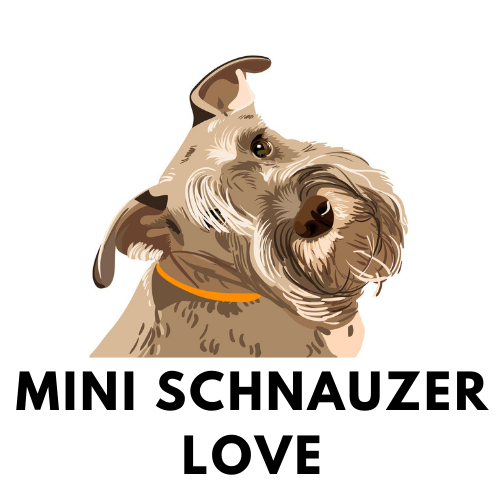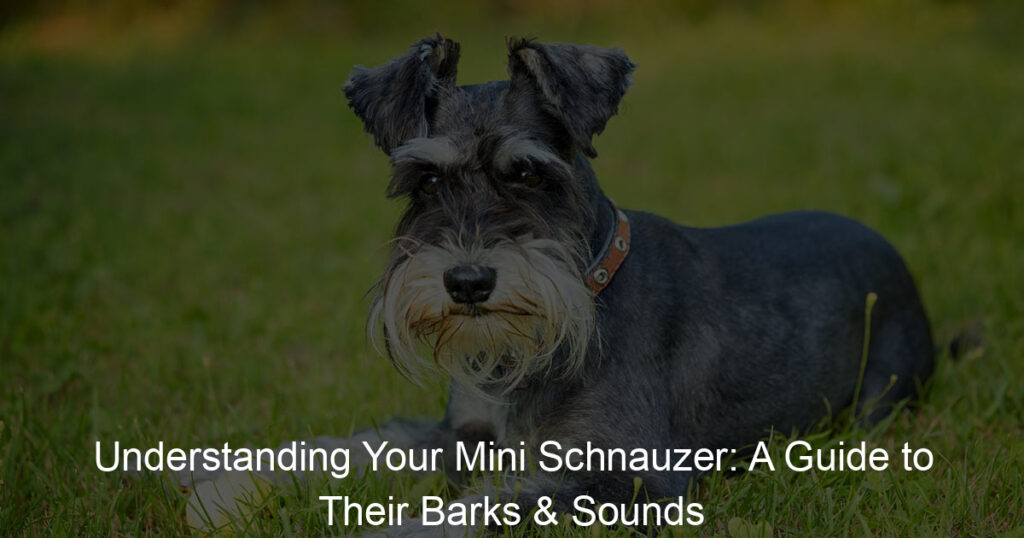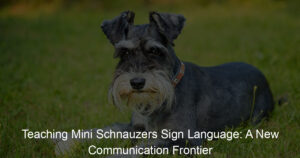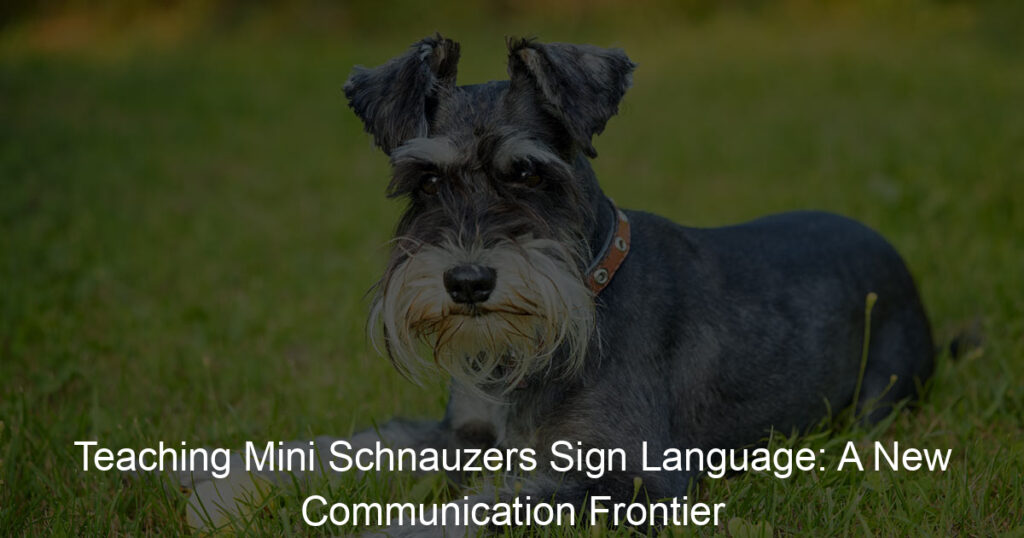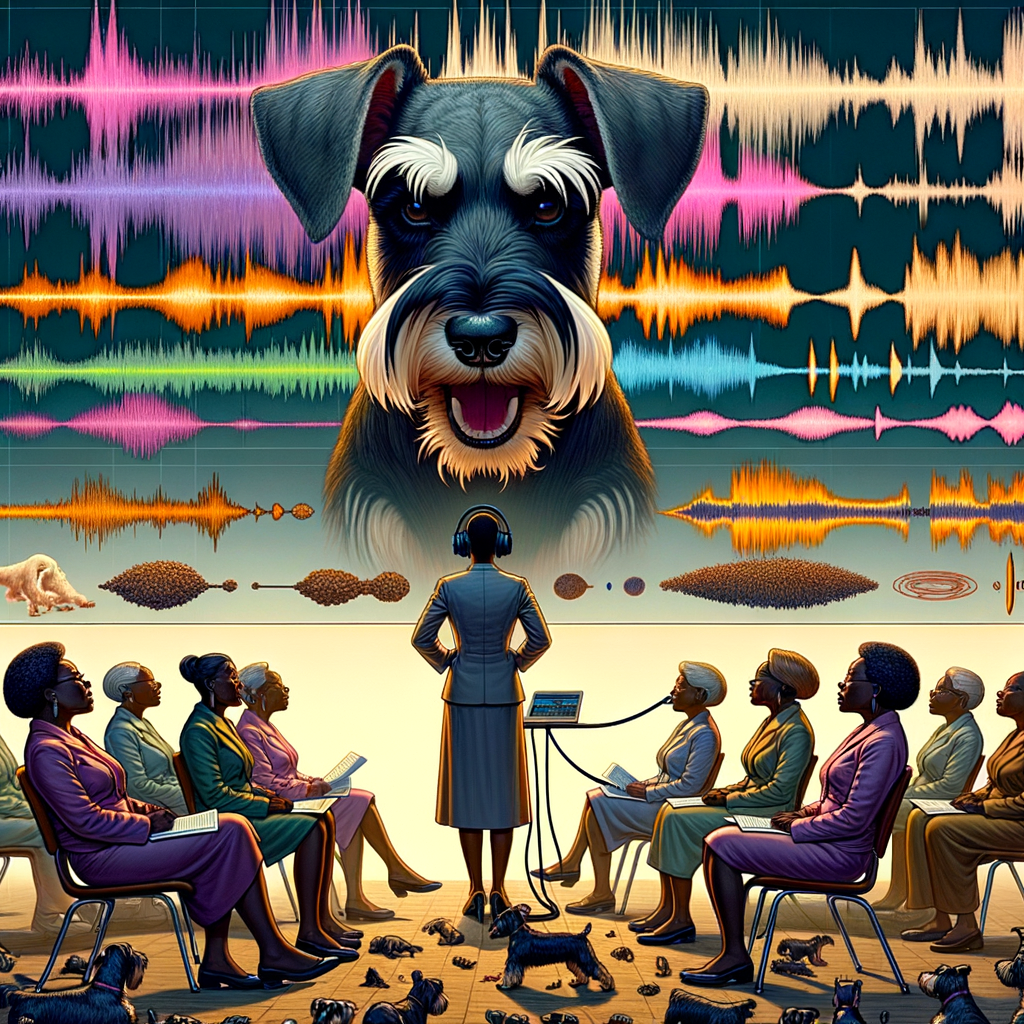
Introduction to Mini Schnauzer Barks and Sounds
As a Mini Schnauzer owner, you’ve probably noticed that your furry friend has a lot to say. But what exactly are they trying to communicate? Understanding your Mini Schnauzer’s barks and sounds can help you better understand their needs, emotions, and even their health. In this section, we’ll explore the importance of understanding your Mini Schnauzer’s vocalizations and provide an overview of common Mini Schnauzer sounds.
- Importance of Understanding Your Mini Schnauzer’s Vocalizations
- Overview of Common Mini Schnauzer Sounds
- Barking: This is a common sound for all dogs, and it can mean a variety of things depending on the pitch, volume, and frequency.
- Whining: This sound often indicates that your Mini Schnauzer is feeling anxious, uncomfortable, or in need of attention.
- Growling: This sound can indicate aggression, but it can also be a sign of playfulness during a game of tug-of-war, for example.
- Howling: While less common in Mini Schnauzers, this sound can indicate loneliness or boredom.
Just like humans, Mini Schnauzers use a variety of sounds to express their feelings and needs. By understanding these vocalizations, you can respond more effectively to your pet’s needs, strengthening your bond and ensuring their well-being. For instance, a certain type of bark may indicate that your Mini Schnauzer is hungry, while another might mean they’re feeling anxious or scared. Recognizing these sounds can help you meet your pet’s needs more quickly and accurately.
Mini Schnauzers are known for their expressive vocalizations. Some of the most common sounds you might hear include:
Remember, these are just general guidelines. Each Mini Schnauzer is unique and may have their own special sounds and signals. The key is to spend time with your pet, observe their behaviors, and learn to understand their unique language.
Decoding Dog Barks: A General Overview
Understanding the language of dogs, particularly their barks, can be a fascinating and rewarding experience. Dogs communicate with us in multiple ways, and one of the most common methods is through barking. By learning to decode these barks, we can better understand our furry friends and respond to their needs more effectively.
- Understanding the Purpose of Dog Barks
Dogs bark for various reasons. It could be a way of expressing joy, fear, or even boredom. Sometimes, a bark may serve as a warning or a call for attention. A dog’s bark can be its way of communicating with its human companions or other animals. It’s important to remember that barking is a natural behavior for dogs and is one of their primary means of communication.
- Common Types of Dog Barks and Their Meanings
While every dog is unique, there are some common types of barks that many dogs share. Here are a few examples:
| Type of Bark | Meaning |
|---|---|
| Continuous, rapid barking | This is often a sign of an immediate perceived threat, such as an intruder. |
| Prolonged or incessant barking, with pauses | This could indicate that the dog is lonely and seeking companionship. |
| One or two sharp, short barks | This is a typical greeting bark, signaling excitement or recognition. |
| Low-pitched, slow bark | This could be a sign of aggression or a warning to stay away. |
By understanding these common types of barks, we can better interpret what our dogs are trying to tell us. Remember, the key to decoding dog barks is patience and careful observation. With time, you’ll become more attuned to your dog’s unique language and be able to respond more effectively to their needs.
Understanding Mini Schnauzer Barks
As a Mini Schnauzer owner, it’s important to understand the different types of barks your furry friend uses to communicate. Each bark has its unique meaning and knowing what your dog is trying to say can greatly improve your relationship with them.
Identifying Different Types of Mini Schnauzer Barks
Mini Schnauzers, like all dogs, have a variety of barks they use to communicate different feelings and intentions. Here are three of the most common types of barks you might hear from your Mini Schnauzer:
- Alert Bark
- Playful Bark
- Anxiety Bark
This is a sharp, loud bark that your Mini Schnauzer uses to alert you of something. It could be a stranger at the door, a car pulling into the driveway, or even a squirrel in the backyard. This bark is typically short and repetitive, signaling urgency and alertness.
A playful bark is usually a series of high-pitched, quick barks that your Mini Schnauzer uses when they’re excited or want to play. You’ll often hear this bark when you get home from work, when it’s time for a walk, or when they’re playing with their favorite toy.
An anxiety bark is a more prolonged, often high-pitched bark that your Mini Schnauzer might use when they’re feeling anxious or stressed. This could be due to a variety of factors, such as being left alone for too long, hearing a loud noise, or being in a new and unfamiliar environment.
Understanding these different types of barks can help you better respond to your Mini Schnauzer’s needs and ensure they’re happy and healthy. Remember, your dog’s bark is their way of communicating with you, so it’s important to listen and respond appropriately.
Interpreting Mini Schnauzer Bark Meanings
As a Mini Schnauzer owner, it’s crucial to understand what your furry friend is trying to communicate. Let’s delve into the meanings behind the different types of barks.
-
Decoding the Alert Bark
The alert bark is a loud, sharp, and repetitive sound that Mini Schnauzers use to signal potential danger or an unfamiliar presence. It’s their way of saying, “Hey, something’s not right here!”
For example, if your Mini Schnauzer starts barking in this manner, they might have noticed a stranger approaching your home or a squirrel running across your yard. It’s their natural instinct to protect their territory and their loved ones.
-
Understanding the Playful Bark
The playful bark is quite different from the alert bark. It’s usually a series of quick, high-pitched yaps that indicate your Mini Schnauzer is in a good mood and ready for some fun.
This type of bark is common during playtime or when your pet is excited about something, like a new toy or a treat. It’s their way of expressing joy and inviting you to join in the fun.
-
Recognizing the Anxiety Bark
The anxiety bark is a more prolonged, low-pitched sound that your Mini Schnauzer might make when they’re feeling stressed or anxious. This could be due to a variety of reasons, such as separation anxiety, fear of loud noises, or unfamiliar environments.
It’s important to recognize this type of bark and provide comfort to your pet. Ignoring or punishing them could exacerbate their anxiety and lead to more serious behavioral issues.
Understanding your Mini Schnauzer’s barks is a step towards better communication and a stronger bond with your pet. Remember, patience and consistency are key in this learning process.
Understanding Mini Schnauzer Sounds
Mini Schnauzers, like all dogs, have a unique way of communicating their feelings and needs. They use a variety of sounds, each with its own meaning. In this section, we will delve into the different types of sounds that Mini Schnauzers make and how to identify them.
Identifying Different Types of Mini Schnauzer Sounds
There are three main types of sounds that Mini Schnauzers typically make: growling, whining, and howling. Each of these sounds can indicate a different emotion or need. Let’s take a closer look at each one.
- Growling
- Whining
- Howling
Growling is a low, guttural sound that Mini Schnauzers make when they are feeling threatened or protective. It’s a warning sign that they are not comfortable with the current situation. This sound could be directed at other animals, strangers, or even objects that they perceive as a threat.
Whining is a high-pitched sound that is often associated with discomfort or distress. Mini Schnauzers may whine when they are feeling anxious, bored, or in need of attention. It’s their way of saying, “I need help” or “I want to be with you”.
Howling is a long, drawn-out sound that is often associated with loneliness or isolation. Mini Schnauzers may howl when they are left alone for extended periods of time or when they hear other dogs howling. It’s their way of communicating with others from a distance.
Understanding these sounds and what they signify can greatly enhance your relationship with your Mini Schnauzer. It allows you to respond appropriately to their needs and emotions, creating a stronger bond between you and your furry friend.
Interpreting Mini Schnauzer Sound Meanings
Understanding the sounds your Mini Schnauzer makes can help you better communicate with your furry friend. Let’s delve into the meanings behind their growls, whines, and howls.
- Decoding the growl
- Understanding the whine
- Recognizing the howl
A growl from a Mini Schnauzer can mean different things. It’s not always a sign of aggression. Sometimes, it’s their way of expressing discomfort or fear. For instance, if they growl when you touch a specific part of their body, it might indicate pain. It’s essential to pay attention to the context and their body language to accurately interpret the growl.
Whining is another common sound Mini Schnauzers make. It’s often a sign that they want something, like food or attention. However, persistent whining can also be a sign of distress or discomfort. If your Mini Schnauzer is whining more than usual, it might be a good idea to consult a vet.
Howling is a form of long-distance communication among dogs. Mini Schnauzers may howl to respond to certain sounds or to express their loneliness. If your Mini Schnauzer is howling frequently when left alone, it might be a sign of separation anxiety.
Understanding your Mini Schnauzer’s sounds is a step towards better communication. Remember, every dog is unique. What applies to one might not apply to another. So, take the time to learn and understand your Mini Schnauzer’s unique language.
Mini Schnauzer Communication: Beyond Barks and Sounds
While barks and sounds are a significant part of how Mini Schnauzers communicate, they also use body language, facial expressions, and tail movements to express their feelings and intentions. Let’s dive deeper into these non-verbal cues.
- Understanding body language
Body language is a powerful communication tool for Mini Schnauzers. When your dog is relaxed, its body will be loose and relaxed as well. If it’s scared or anxious, you may notice its body becoming stiff. A playful Mini Schnauzer will have a bouncy, light movement. Observing your dog’s body language can provide you with valuable insights into its emotional state.
- Recognizing facial expressions
Facial expressions are another important aspect of Mini Schnauzer communication. For instance, a relaxed Mini Schnauzer will have soft eyes and a slightly open mouth. If your dog is feeling threatened or scared, it might show the whites of its eyes, known as ‘whale eye’. A Mini Schnauzer’s ears are also very expressive – they might be pulled back if the dog is scared or pointed forward if it’s alert or interested.
- Interpreting tail movements
Lastly, tail movements can tell you a lot about what your Mini Schnauzer is feeling. A wagging tail doesn’t always mean a happy dog. The speed and direction of the wag can indicate different emotions. For example, a slow wag with the tail at half-mast can be a sign of insecurity, while a tail that wags more to the right side of the dog’s body is often a sign of positive feelings.
Understanding these non-verbal cues can significantly enhance your communication with your Mini Schnauzer, leading to a stronger bond and a happier pet.
| Communication Type | Signs | Meaning |
|---|---|---|
| Body Language | Loose, relaxed body | Relaxed, comfortable |
| Body Language | Stiff body | Anxious, scared |
| Facial Expression | Soft eyes, slightly open mouth | Relaxed, comfortable |
| Facial Expression | ‘Whale eye’, ears pulled back | Threatened, scared |
| Tail Movement | Slow wag, tail at half-mast | Insecure |
| Tail Movement | Wags more to the right side | Positive feelings |
Case Studies: Real-Life Examples of Decoding Mini Schnauzer Barks and Sounds
Let’s delve into some real-life examples that can help us understand the different types of Mini Schnauzer barks and sounds. These case studies will provide a practical perspective on how to interpret and respond to our furry friends’ communication.
- Case study 1: Alert bark
- Case study 2: Anxiety bark
- Case study 3: Playful howl
Meet Bella, a 3-year-old Mini Schnauzer. Bella has a distinct bark when someone approaches the front door. It’s a series of short, sharp barks, usually in quick succession. This is Bella’s alert bark, her way of signaling that there’s someone at the door. Her owners have learned to distinguish this bark from her other sounds, allowing them to respond appropriately when Bella alerts them.
Next, we have Max, a 2-year-old Mini Schnauzer. Max’s owners noticed that he has a different bark when he’s anxious or scared. It’s a lower pitched, prolonged bark, often accompanied by whimpering sounds. This usually happens during thunderstorms or when he’s left alone for too long. Recognizing this anxiety bark has helped Max’s owners to comfort him during stressful situations.
Finally, let’s look at Daisy, a playful 4-year-old Mini Schnauzer. Daisy has a unique howl she uses when she’s in a playful mood. It’s a high-pitched, elongated sound, different from her usual barks. Daisy’s owners have learned to recognize this playful howl and know that it’s Daisy’s way of asking for playtime. This understanding has helped them to keep Daisy happy and active.
These case studies highlight the importance of understanding the different barks and sounds of your Mini Schnauzer. By paying close attention to their unique sounds, you can better understand their needs and emotions, leading to a stronger bond between you and your pet.
Key Takeaways: Understanding Your Mini Schnauzer’s Communication
As we conclude this informative journey into the world of Mini Schnauzer communication, let’s summarize the most important points we’ve learned. These key takeaways will help you better understand your Mini Schnauzer’s unique sounds and barks, and how to respond to them in a way that encourages positive behavior.
- Importance of patience and observation
- Value of understanding your Mini Schnauzer’s unique sounds
- Role of positive reinforcement in encouraging desired vocalizations
Understanding your Mini Schnauzer’s communication requires time and patience. Each dog has its own unique way of expressing itself, and it’s essential to observe your pet closely to decode its barks and sounds. Remember, your Mini Schnauzer isn’t just making noise; it’s trying to communicate with you. Patience and observation are the keys to understanding what your pet is trying to say.
Each Mini Schnauzer has a unique set of sounds and barks that it uses to communicate different needs and emotions. By understanding these sounds, you can respond more effectively to your pet’s needs and strengthen your bond. For instance, a high-pitched, repetitive bark might indicate excitement or a need for attention, while a low, prolonged growl could signal fear or discomfort.
Positive reinforcement plays a crucial role in shaping your Mini Schnauzer’s vocal behavior. By rewarding your pet with treats, praise, or playtime when it communicates in a desired way, you can encourage more of the same behavior. For example, if your Mini Schnauzer barks to alert you of a stranger at the door, rewarding it with a treat can reinforce this behavior and encourage your pet to continue acting as a vigilant watchdog.
In conclusion, understanding your Mini Schnauzer’s communication is a rewarding journey that requires patience, observation, and a positive approach. By taking the time to understand your pet’s unique sounds and using positive reinforcement to encourage desired vocalizations, you can build a stronger bond with your Mini Schnauzer and ensure a happier, healthier life for your furry friend.
